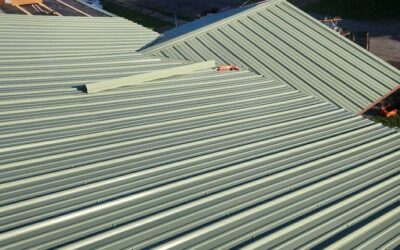Roof Ventilation in Lake County, Ohio: Why It’s Essential for Your Home
Roof ventilation is a crucial aspect of maintaining the health, efficiency, and longevity of your home. In areas like Lake County, Ohio, where the climate can experience extreme temperatures, proper roof ventilation can make a significant difference in how your home performs, both in terms of comfort and energy efficiency. Whether you’re building a new home or replacing an old roof, understanding the role of ventilation in your roofing system is essential.
At S&K Construction and Remodeling LLC, we specialize in roofing services for homeowners across Lake County, OH. As an Owens Corning Preferred Contractor, we pride ourselves on providing reliable, high-quality roofing solutions that improve the overall performance of your home. In this blog post, we’ll explore the importance of roof ventilation, how it works, the benefits it offers, and the different types of ventilation systems that can enhance your roof’s effectiveness.
What Is Roof Ventilation?
Roof ventilation refers to the system of air vents installed on your roof that allows for the proper circulation of air. This system works by allowing warm, moist air to escape the attic and replacing it with cooler, drier air from outside. Roof ventilation systems typically consist of two main types of vents: intake vents and exhaust vents. These vents work together to maintain a balance of airflow in the attic space, which helps regulate temperature and moisture levels.
Why Is Roof Ventilation Important?
Proper roof ventilation plays a vital role in the overall performance of your roofing system. Here’s why it’s essential, especially in regions like Lake County, Ohio.
1. Prevents Heat Buildup
In Lake County, Ohio, summers can bring intense heat and humidity. Without proper ventilation, the temperature in your attic can rise dramatically, causing heat buildup. This trapped heat can lead to a variety of problems, including:
- Increased cooling costs: The excess heat can penetrate into the living spaces of your home, forcing your air conditioning system to work harder and driving up energy bills.
- Premature roof damage: The heat buildup can cause your roofing materials to deteriorate more quickly. Over time, this can lead to warping, cracking, and other forms of damage to the shingles and other roofing components.
- Reduced comfort: A poorly ventilated roof can cause your home’s interior to feel warmer and less comfortable, even with the air conditioning running.
By promoting proper airflow through the attic, roof ventilation helps keep the temperature in check, reducing heat buildup and ensuring a more comfortable living space.
2. Prevents Moisture Damage
Moisture is one of the most significant threats to the integrity of your roof. Without proper ventilation, moisture can accumulate in the attic, leading to several issues, including:
- Mold and mildew growth: Warm, moist air trapped in the attic can create the perfect conditions for mold and mildew to grow. These fungal infestations can compromise the structural integrity of your roof and pose health risks to your family.
- Wood rot: Prolonged exposure to moisture can cause wood in your attic, such as rafters and roof decking, to rot. This can weaken the structure of your roof and lead to costly repairs.
- Ice dams: In the winter months, moisture buildup can contribute to the formation of ice dams, which occur when snow on the roof melts due to trapped heat and then refreezes at the eaves. Ice dams can cause water to back up under the shingles, leading to leaks and water damage inside your home.
Proper roof ventilation helps regulate humidity levels and prevents moisture from accumulating in the attic, reducing the risk of these costly issues.
3. Improves Energy Efficiency
By reducing the amount of heat that builds up in the attic, proper roof ventilation can help lower your energy costs. During the summer, attic temperatures can soar without ventilation, causing your cooling system to work overtime. In winter, improper ventilation can lead to heat loss, forcing your heating system to work harder.
A well-ventilated roof helps your home maintain a more consistent internal temperature, reducing the strain on your HVAC system. This can result in lower energy bills throughout the year and a more energy-efficient home.
4. Extends Roof Lifespan
Proper ventilation can extend the lifespan of your roof by preventing the buildup of heat and moisture that can cause premature wear and tear. When your roof is exposed to constant heat or moisture, the roofing materials can break down more quickly. This can lead to the need for more frequent repairs and replacements.
With proper ventilation, your roofing materials are better protected from the elements, which can help them last longer and delay the need for a costly roof replacement.
How Roof Ventilation Works
Roof ventilation works by creating a natural flow of air through the attic, preventing heat and moisture from becoming trapped. The basic principle behind roof ventilation is the balance of intake and exhaust ventilation.
- Intake vents are installed near the eaves of the roof, allowing cool air to enter the attic.
- Exhaust vents are installed near the ridge or peak of the roof, allowing warm, moist air to escape.
The combination of intake and exhaust vents creates a system that promotes continuous airflow, helping to keep the attic temperature regulated and moisture levels under control. The result is a healthier and more energy-efficient roofing system.
Types of Roof Ventilation Systems
There are several types of roof ventilation systems available, each designed to meet the specific needs of your home. The most common types include:
1. Ridge Vents
A ridge vent is installed along the peak of the roof and is one of the most effective types of exhaust vents. It allows hot air to escape from the attic and is often paired with intake vents at the eaves to create a continuous flow of air.
Ridge vents are a popular choice for many homeowners because they are unobtrusive, blend seamlessly with the roofline, and provide efficient ventilation. Additionally, they help prevent the formation of ice dams in colder climates by allowing warm air to escape.
2. Soffit Vents
Soffit vents are installed along the eaves or underside of the roof’s overhang. These vents serve as intake vents, allowing fresh, cool air to enter the attic. Soffit vents are typically paired with ridge vents for optimal airflow.
Soffit vents are often used in combination with other types of ventilation systems to create a balanced and efficient airflow.
3. Gable Vents
Gable vents are installed on the gable ends of the roof, typically near the top of the walls. These vents allow air to flow through the attic from one side to the other, promoting cross-ventilation.
While gable vents can be effective, they are often less efficient than ridge and soffit vent combinations because they don’t create a continuous flow of air. However, they can still be a viable option for homes with specific ventilation needs.
4. Turbinator Vents
A turbine vent is a type of exhaust vent that uses wind power to help expel hot air from the attic. These vents feature a spinning, cylindrical design that helps improve airflow by creating a vacuum effect. As wind blows, it causes the turbine to spin, drawing hot air out of the attic.
Turbine vents are often used in areas where wind is a reliable source of power, but they can be less effective in low-wind conditions.
5. Powered Vents
Powered vents are mechanically operated vents that use a fan to draw air out of the attic. These vents are typically installed near the roof’s peak and are powered by electricity or solar panels.
Powered vents can be highly effective in homes with large attics or areas where natural airflow may not be sufficient. However, they can increase energy usage, so they are often used as a supplement to other types of ventilation.
The Importance of Proper Roof Ventilation in Lake County, OH
In Lake County, Ohio, the climate can vary greatly throughout the year. Winters bring cold temperatures and snow, while summers can be hot and humid. Proper roof ventilation is particularly important in this region for several reasons:
- Preventing Ice Dams: During the winter months, heat buildup in the attic can cause snow on the roof to melt. When the water refreezes at the eaves, it can create ice dams that lead to water infiltration and damage. Proper ventilation helps prevent this by keeping the attic temperature consistent and preventing snow from melting prematurely.
- Energy Efficiency: As temperatures fluctuate between the seasons, energy efficiency is a concern. In the summer, a poorly ventilated attic can increase cooling costs, while in the winter, improper ventilation can lead to heat loss and higher heating costs. Proper ventilation helps balance temperatures, reducing the workload on your HVAC system and lowering your energy bills.
- Moisture Control: Lake County’s humidity levels can be high, especially during the warmer months. Proper roof ventilation helps regulate moisture levels in the attic, preventing mold, mildew, and wood rot that can occur when moisture is trapped.
Conclusion: Get the Right Roof Ventilation for Your Home in Lake County, OH
Proper roof ventilation is essential for maintaining the health, energy efficiency, and longevity of your home’s roofing system. Whether you’re looking to prevent heat buildup, moisture damage, or ice dams, a well-ventilated roof can help you achieve all of these goals. At S&K Construction and Remodeling LLC, we specialize in installing high-quality roof ventilation systems that are tailored to meet the unique needs of homeowners in Lake County, OH.
If you’re ready to improve your home’s roof ventilation or need an expert to inspect your existing system, contact us today for a consultation. We’re here to help you keep your roof in top condition and ensure that your home stays comfortable, efficient, and safe for years to come.
 (440) 307-2060
(440) 307-2060

